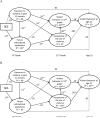Predicting violent behavior: The role of violence exposure and future educational aspirations during adolescence
- PMID: 26282242
- PMCID: PMC4575886
- DOI: 10.1016/j.adolescence.2015.07.017
Predicting violent behavior: The role of violence exposure and future educational aspirations during adolescence
Abstract
Few researchers have explored future educational aspirations as a promotive factor against exposure to community violence in relation to adolescents' violent behavior over time. The present study examined the direct and indirect effect of exposure to community violence prior to 9th grade on attitudes about violence and violent behavior in 12th grade, and violent behavior at age 22 via 9th grade future educational aspirations in a sample of urban African American youth (n = 681; 49% male). Multi-group SEM was used to test the moderating effect of gender. Exposure to violence was associated with lower future educational aspirations. For boys, attitudes about violence directly predicted violent behavior at age 22. For boys, future educational aspirations indirectly predicted less violent behavior at age 22. Implications of the findings and suggestions for future research are discussed.
Keywords: Adolescence; Exposure to violence; Future educational aspirations; Longitudinal; Violent behavior.
Copyright © 2015 The Foundation for Professionals in Services for Adolescents. Published by Elsevier Ltd. All rights reserved.
Figures



Similar articles
-
Community exposure to gun homicide and adolescents' educational aspirations.J Adolesc. 2024 Jul;96(5):1137-1152. doi: 10.1002/jad.12324. Epub 2024 Apr 8. J Adolesc. 2024. PMID: 38584575
-
Thinking about the future as a way to succeed in the present: a longitudinal study of future orientation and violent behaviors among African American youth.Am J Community Psychol. 2011 Dec;48(3-4):238-46. doi: 10.1007/s10464-010-9383-0. Am J Community Psychol. 2011. PMID: 21104432 Free PMC article.
-
Youth violence in South Africa: exposure, attitudes, and resilience in Zulu adolescents.Violence Vict. 2012;27(2):166-81. doi: 10.1891/0886-6708.27.2.166. Violence Vict. 2012. PMID: 22594214
-
The effect of direct and indirect exposure to violence on youth survival expectations.J Adolesc Health. 2014 Dec;55(6):817-22. doi: 10.1016/j.jadohealth.2014.06.019. Epub 2014 Sep 6. J Adolesc Health. 2014. PMID: 25204591
-
Emotional Desensitization to Violence Contributes to Adolescents' Violent Behavior.J Abnorm Child Psychol. 2016 Jan;44(1):75-86. doi: 10.1007/s10802-015-9986-x. J Abnorm Child Psychol. 2016. PMID: 25684447 Free PMC article.
Cited by
-
Pathways from Childhood Adversity to Problem Behaviors in Young Adulthood: The Mediating Role of Adolescents' Future Expectations.J Youth Adolesc. 2017 Jan;46(1):1-14. doi: 10.1007/s10964-016-0597-9. Epub 2016 Nov 3. J Youth Adolesc. 2017. PMID: 27812837
-
The association between early exposure to violence in emerging adulthood and substance use in early-adulthood among inner-city individuals.Emerg Adulthood. 2018 Aug;6(4):235-242. doi: 10.1177/2167696817725455. Epub 2017 Sep 4. Emerg Adulthood. 2018. PMID: 31656695 Free PMC article.
-
Beyond the Situation: Hanging Out with Peers now is Associated with Short-Term Mindsets Later.J Dev Life Course Criminol. 2024;10(1):51-72. doi: 10.1007/s40865-024-00249-2. Epub 2024 Feb 17. J Dev Life Course Criminol. 2024. PMID: 38841100 Free PMC article.
-
Feasibility and acceptability of a future-oriented empowerment program to prevent substance use and school dropout among school-disengaged youth.Public Health Nurs. 2020 Mar;37(2):251-261. doi: 10.1111/phn.12706. Epub 2020 Jan 16. Public Health Nurs. 2020. PMID: 31950544 Free PMC article.
-
Adolescent Exposure to Violence and Intimate-Partner Violence Mediated by Mental Distress.J Appl Dev Psychol. 2021 Jan-Feb;72:101215. doi: 10.1016/j.appdev.2020.101215. Epub 2020 Nov 19. J Appl Dev Psychol. 2021. PMID: 33384463 Free PMC article.
References
-
- Agnew R. Foundation for a general strain theory of crime and delinquency. Criminology. 1992;30:47–87.
-
- Agnew R, White HR. An empirical test of general strain theory. Criminology. 1992;30:475–499.
-
- Aisenberg E, Herrenkohl T. Community violence in context: risk and resilience in children and families. Journal of Interpersonal Violence. 2008;23:296–315. - PubMed
-
- Alston ST. Future aspirations and African-American adolescents: an exploration of aspirations as a protective factor for positive youth development of African-American adolescent in public housing. Dissertation Abstracts International Section A: Humanities and Social Sciences. 2009;70:2009–99211-206.
-
- Anderson CA, Bushman BJ. Human aggression. Annual Review of Psychology. 2002;53:27–51. - PubMed
Publication types
MeSH terms
Grants and funding
LinkOut - more resources
Full Text Sources
Other Literature Sources

